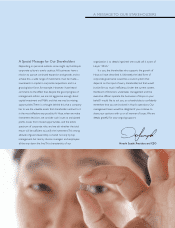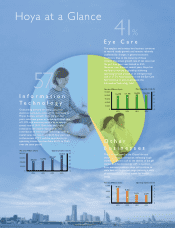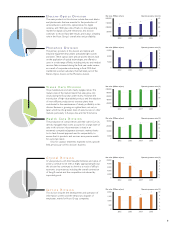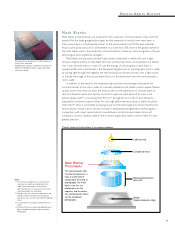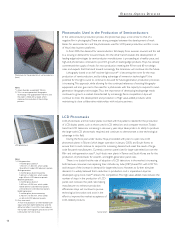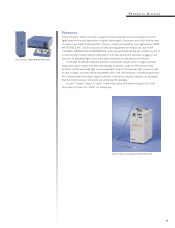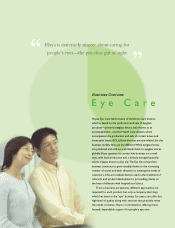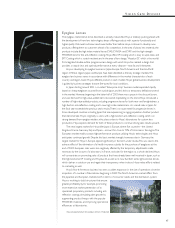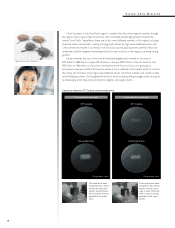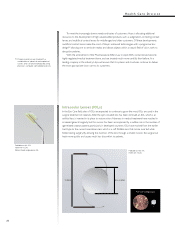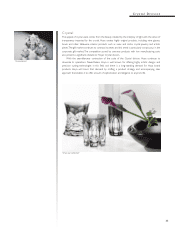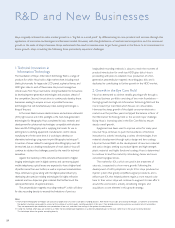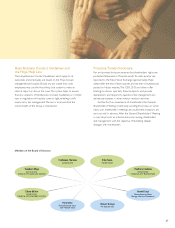Pentax 2005 Annual Report Download - page 19
Download and view the complete annual report
Please find page 19 of the 2005 Pentax annual report below. You can navigate through the pages in the report by either clicking on the pages listed below, or by using the keyword search tool below to find specific information within the annual report.
Vision Care Division
Mass production plant for eyeglass lenses (Thailand)
Eyeglass Lenses
The eyeglass market tends to be described as already mature. But Hoya is tirelessly pushing ahead with
the development of new lens technologies, always offering products with superior functionality and
higher quality that meet customer needs even better than before. Hoya continues to develop new
products, offering them to customers ahead of its competitors. In the area of plastic lens materials, the
products include: the high index material lenses EYAS, EYNOA and EYRY and the high-strength
PHOENIX lens; for the anti-reflection coating, Hoya offers VP Coating, which is easy to wipe clean, and
SFT Coating, which is scratch-resistant; and in the area of lens design, “Hoyalux iD,” which is the world’s
first integrated double-surface progressive lens design, with which Hoya has realized a design that
provides a natural view and optimal performance at every distance—near, far, and in-between.
Hoya is developing its eyeglass business in Japan, Europe, North America and the Asia-Pacific
region. Of these regions, Japan and Europe have been identified as the key strategic markets. The
eyeglass lens business varies in accordance with differences in the market characteristics of each
country and region. Given Hoya’s different position in each market, Hoya’s global business development
is guided by business strategies that are fine-tuned for local conditions.
In Japan, starting around 2001, a so-called “three-price shop” business model expanded rapidly,
based on cheap eyeglasses sourced from outside Japan, and this led to a temporary deflationary trend
in the market. However, beginning in the latter half of 2003 there was a pause in the discount boom,
and user demand for high-value-added items recovered. Capitalizing on this trend, Hoya introduced a
number of high-value-added products, including progressive lenses for both near- and far-sightedness, a
high-function anti-reflection coating, and a new high index material lens. As a result, sales in Japan for
the fiscal year exceeded the previous year’s results. There is an acute need for progressive lenses in
those developed countries including Japan that are experiencing an aging population. Another product
that demonstrates Hoya’s originality is a lens with a high-function anti-reflection coating, which is in
strong demand from eyeglass retailers, who place orders to Hoya’s laboratories for custom lens
production. Hoya expects demand for both of these products to continue driving sales results upward.
The next largest market for Hoya after Japan is Europe, where five countries—the United
Kingdom, France, Germany, Italy and Spain—account for close to 70% of total sales in the region. The
European market readily accepts high-performance products utilizing Hoya’s technologies, and Hoya
anticipates continued growth. Despite this basic market strength, however, sales in Germany, the
largest market for Hoya in Europe, slipped significantly in the term under review. This was due to the
adverse effect of the elimination of a health insurance subsidy for the purchase of eyeglasses at the
end of 2003. European sales were also negatively affected by the temporary adjustments made
necessary by the closure of a laboratory in France, and sales for the region as a whole declined. Hoya
will concentrate on promoting sales of products that have already been well received in Japan, such as
the high-functional VP Coating and Hoyalux iD, as well as its new SunTech series light-sensitive lenses,
which darken in outdoor use and regain their transparency when indoors. Hoya makes efforts related
to marketing as well.
Hoya’s North American business has seen a sudden expansion in the size of operations since the
acquisition of a number of laboratories beginning in 2000. The North American market differs from
the Japanese and European markets, both in terms of consumer needs and the distribution system.
Hoya is working to build structures that ensure
greater profitability, by, for example, promoting
more extensive market penetration of its
specialized, proprietary products including anti-
reflection coatings, stimulating sales growth by
augmenting product lineups with the popular
PHOENIX materials, and improving operational
efficiencies at laboratories.


